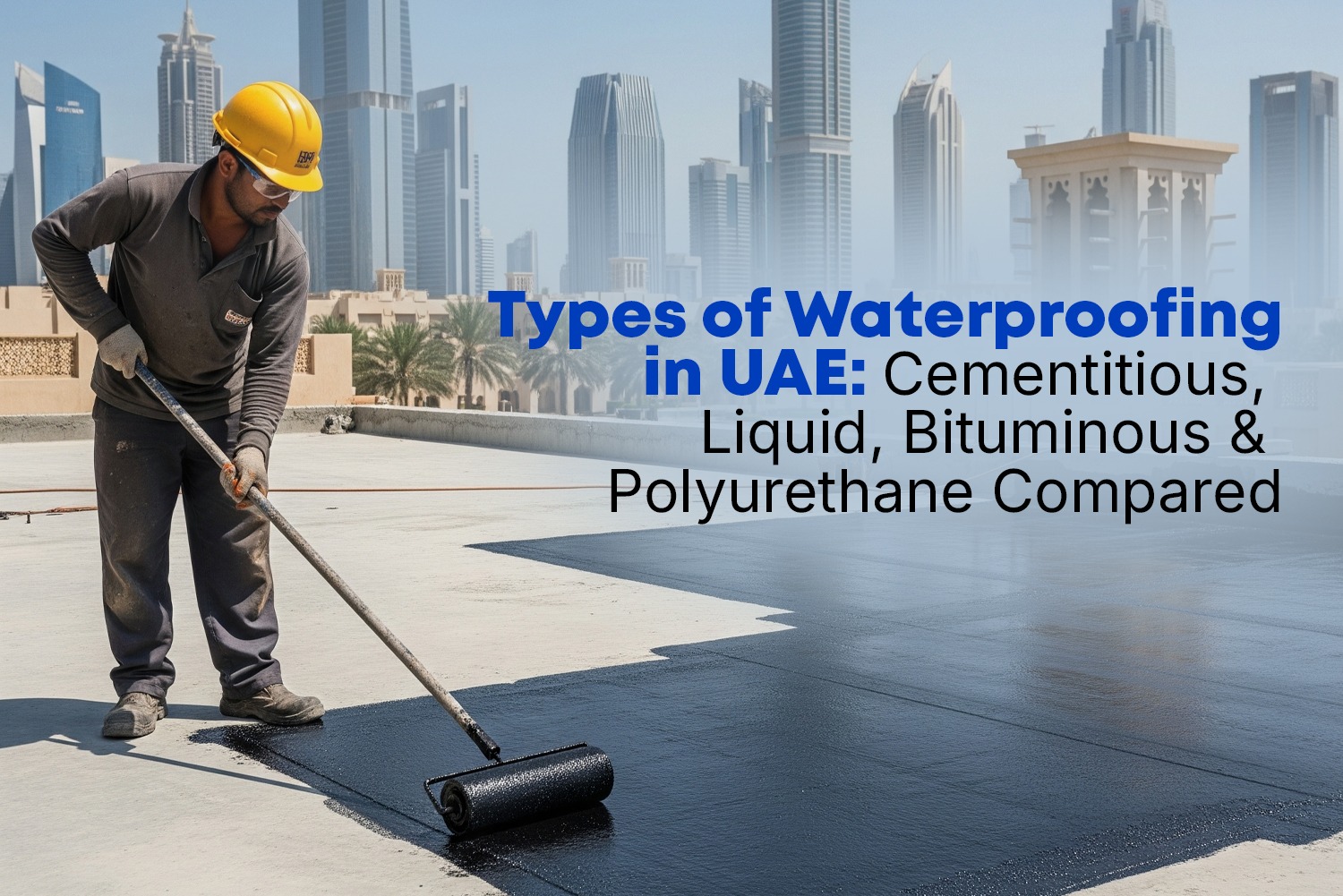Let’s get straight to the point. Water damage is a huge issue in UAE buildings. Knowing the types of waterproofing is what will keep your buildings safe. Selecting the wrong kind wastes time, money, and materials.
Here’s what you should do: learn about each type of waterproofing, their applications, and advantages. Then select the one that suits your project.
What Are the Types of Waterproofing?
Waterproofing keeps water out of buildings and structures and prevents damage. In the UAE, four types of waterproofing types are most prevalent in the market:
- Cementitious Waterproofing
- Liquid Waterproofing
- Bituminous Waterproofing
- Polyurethane Waterproofing
All have pros, cons, and best applications. Let’s run through them.
- Cementitious Waterproofing
The following is important: cementitious waterproofing is simple to apply and suitable for concrete and masonry structures.
Use: Bathrooms, water tanks, foundations.
Advantages: High adhesion, long-lasting, economical.
Disadvantage: Not very flexible; cracking occurs if the building moves.
Do this: apply cementitious to internal spaces and buildings that do not move much.
- Liquid Waterproofing
Liquid waterproofing forms a flexible, seamless film when applied.
Application: Roofs, balconies, terraces.
Advantages: Flexible with slight movements, simple to apply, seamless protection.
Disadvantage: Requires multiple coats for complete protection.
Here’s what you need to know: it performs well in UAE sun-and-rain-exposed roofs, providing a long-lasting barrier.
- Bituminous Waterproofing
Bituminous waterproofing employs asphalt-based membranes.
Application: Basements, foundations, terraces.
Advantages: Durable barrier, UV resistant, long life.
Disadvantage: Needs skilled labor and precise installation.
This is what to do: use bituminous for locations requiring additional durability and sun resistance.
- Polyurethane Waterproofing
Polyurethane waterproofing is a new, high-performance option.
Use: Flat roofs, terraces, exposed structures.
Benefits: Flexible, seamless, resistant to UV, chemicals, and water ponding.
Drawback: Higher cost, surface must be clean and dry before application.
Here’s what matters: use polyurethane for premium finishes or areas with heavy sun and water exposure.
How to Choose the Right Waterproofing Type
Let’s cut to the chase. Choosing the right waterproofing depends on:
- Surface type: Concrete, masonry, metal, or asphalt.
- Exposure: Sun, rain, or ponding water.
- Budget: Some options are more expensive initially but are longer-lasting.
- Flexibility needs: When the structure shifts, flexible finishes such as liquid or polyurethane are better.
This is what you need to do: analyze your structure, setting, and budget. Next, choose a solution that complements protection, price, and longevity.
Why UAE Businesses and Contractors Should Care
Water damage may cause structural failure, repair expenses, and business disruption. Understand the waterproofing types to make your projects long-lasting. The wrong technique is more expensive in the long term.
Collaborate with professionals such as Petroline Tech to provide correct application and long-lasting protection.
For more advice, refer to this article on Waterproofing Methods and Best Practices.
Conclusion
Here’s the summary: every type of waterproofing serves a purpose. Cementitious is easy and robust, liquid is adaptable, bituminous is long-lasting, and polyurethane provides top-shelf protection.
This is what you do: evaluate your project, select the appropriate type, and apply properly. That’s how you prevent water damage and safeguard your UAE building.
Need expert waterproofing solutions? Contact Petroline Tech today and shield your structures.

